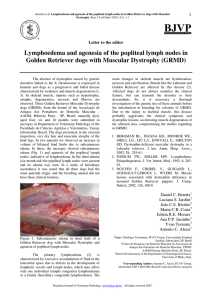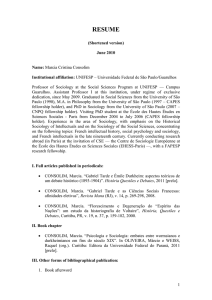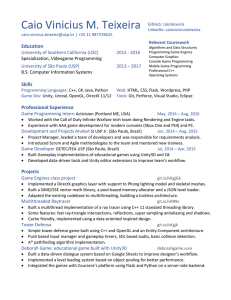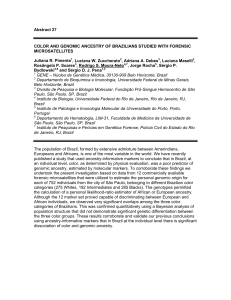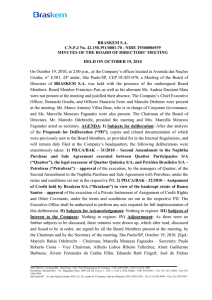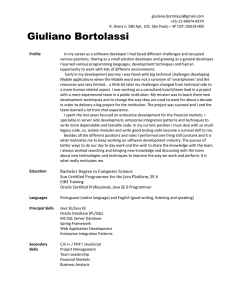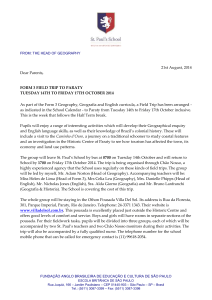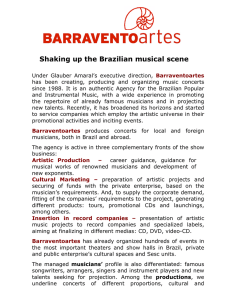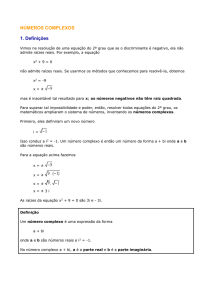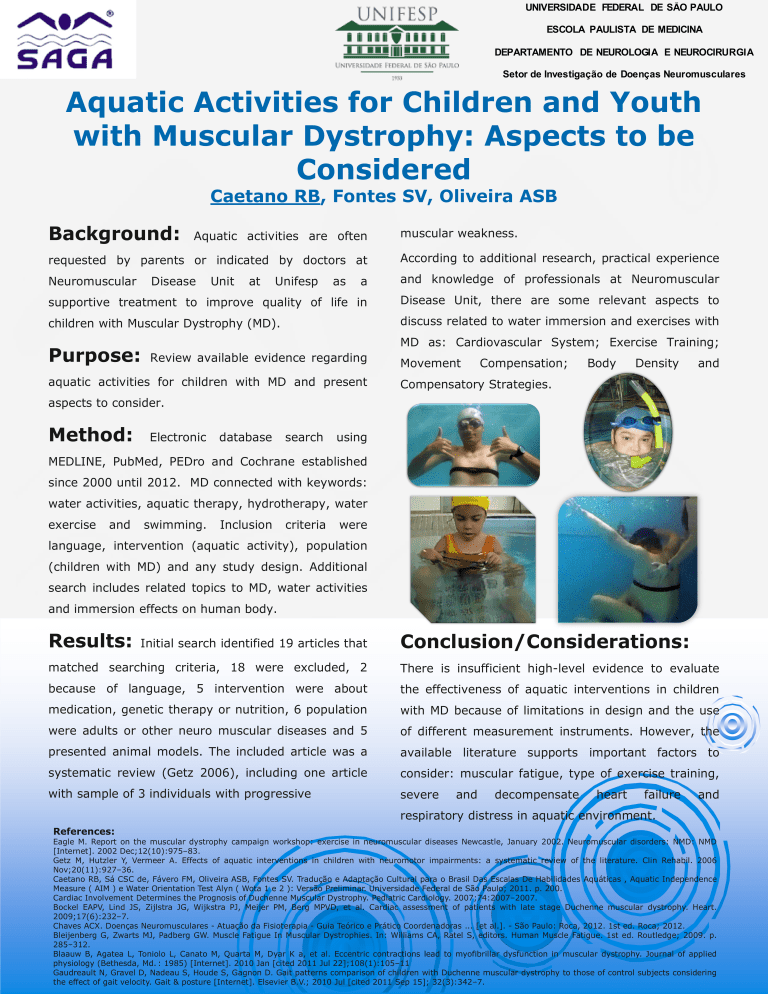
UNIVERSIDADE FEDERAL DE SÃO PAULO
ESCOLA PAULISTA DE MEDICINA
DEPARTAMENTO DE NEUROLOGIA E NEUROCIRURGIA
Setor de Investigação de Doenças Neuromusculares
Aquatic Activities for Children and Youth
with Muscular Dystrophy: Aspects to be
Considered
Caetano RB, Fontes SV, Oliveira ASB
Background:
Aquatic activities are often
muscular weakness.
requested by parents or indicated by doctors at
According to additional research, practical experience
Neuromuscular
a
and knowledge of professionals at Neuromuscular
supportive treatment to improve quality of life in
Disease Unit, there are some relevant aspects to
children with Muscular Dystrophy (MD).
discuss related to water immersion and exercises with
Disease
Purpose:
Unit
at
Unifesp
as
MD as: Cardiovascular System; Exercise Training;
Review available evidence regarding
aquatic activities for children with MD and present
Movement
Compensation;
Body
Density
and
Compensatory Strategies.
aspects to consider.
Method:
Electronic
database
search
using
MEDLINE, PubMed, PEDro and Cochrane established
since 2000 until 2012. MD connected with keywords:
water activities, aquatic therapy, hydrotherapy, water
exercise
and
swimming.
Inclusion
criteria
were
language, intervention (aquatic activity), population
(children with MD) and any study design. Additional
search includes related topics to MD, water activities
and immersion effects on human body.
Results:
Initial search identified 19 articles that
Conclusion/Considerations:
matched searching criteria, 18 were excluded, 2
There is insufficient high-level evidence to evaluate
because of language, 5 intervention were about
the effectiveness of aquatic interventions in children
medication, genetic therapy or nutrition, 6 population
with MD because of limitations in design and the use
were adults or other neuro muscular diseases and 5
of different measurement instruments. However, the
presented animal models. The included article was a
available literature supports important factors to
systematic review (Getz 2006), including one article
consider: muscular fatigue, type of exercise training,
with sample of 3 individuals with progressive
severe
and
decompensate
heart
failure
and
respiratory distress in aquatic environment.
References:
Eagle M. Report on the muscular dystrophy campaign workshop: exercise in neuromuscular diseases Newcastle, January 2002. Neuromuscular disorders: NMD: NMD
[Internet]. 2002 Dec;12(10):975–83.
Getz M, Hutzler Y, Vermeer A. Effects of aquatic interventions in children with neuromotor impairments: a systematic review of the literature. Clin Rehabil. 2006
Nov;20(11):927–36.
Caetano RB, Sá CSC de, Fávero FM, Oliveira ASB, Fontes SV. Tradução e Adaptação Cultural para o Brasil Das Escalas De Habilidades Aquáticas , Aquatic Independence
Measure ( AIM ) e Water Orientation Test Alyn ( Wota 1 e 2 ): Versão Preliminar. Universidade Federal de São Paulo; 2011. p. 200.
Cardiac Involvement Determines the Prognosis of Duchenne Muscular Dystrophy. Pediatric Cardiology. 2007;74:2007–2007.
Bockel EAPV, Lind JS, Zijlstra JG, Wijkstra PJ, Meijer PM, Berg MPVD, et al. Cardiac assessment of patients with late stage Duchenne muscular dystrophy. Heart.
2009;17(6):232–7.
Chaves ACX. Doenças Neuromusculares - Atuação da Fisioterapia - Guia Teórico e Prático Coordenadoras ... [et al.]. - São Paulo: Roca, 2012. 1st ed. Roca; 2012.
Bleijenberg G, Zwarts MJ, Padberg GW. Muscle Fatigue In Muscular Dystrophies. In: Williams CA, Ratel S, editors. Human Muscle Fatigue. 1st ed. Routledge; 2009. p.
285–312.
Blaauw B, Agatea L, Toniolo L, Canato M, Quarta M, Dyar K a, et al. Eccentric contractions lead to myofibrillar dysfunction in muscular dystrophy. Journal of applied
physiology (Bethesda, Md. : 1985) [Internet]. 2010 Jan [cited 2011 Jul 22];108(1):105–11
Gaudreault N, Gravel D, Nadeau S, Houde S, Gagnon D. Gait patterns comparison of children with Duchenne muscular dystrophy to those of control subjects considering
the effect of gait velocity. Gait & posture [Internet]. Elsevier B.V.; 2010 Jul [cited 2011 Sep 15]; 32(3):342–7.

